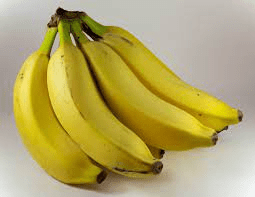Banana fruit Health Benefits, its Origin and Cultivation, Uses of Different Parts of this plant, Interesting Facts to know
Here we will learn Banana Fruit Health Benefits and many important things about Banana Fruit.

Bananas are one of the most popular fruits in the world. They are packed with nutrients and offer a wide range of health benefits. In this article, we will discuss the scientific name, plant description, origin, cultivation, interesting facts, health benefits, and uses of different parts of the plant of bananas.
Scientific Name and Plant Description: The scientific name of the banana plant is Musa acuminata. Bananas are herbaceous plants that grow up to 30 feet tall. The leaves are large and oval-shaped, and the fruit grows in clusters from the top of the plant. The fruit is elongated and curved, with a thick peel that is typically yellow when ripe.
Botanical Classification of Banana Fruit:
The botanical classification of the banana fruit is as follows:
Kingdom: Plantae (Plants)
Subkingdom: Tracheobionta (Vascular plants)
Superdivision: Spermatophyta (Seed plants)
Division: Magnoliophyta (Flowering plants)
Class: Liliopsida (Monocotyledons)
Subclass: Commelinidae
Order: Zingiberales
Family: Musaceae (Banana family)
Genus: Musa
Species: Musa acuminata
Therefore, the botanical name of the banana fruit is Musa acuminata.
Origin and Cultivation:
Bananas are native to Southeast Asia and have been cultivated for thousands of years. Today, they are grown in many tropical regions around the world, including Africa, Central and South America, and the Caribbean. Bananas are typically grown in large plantations and are harvested when they are green. They have then ripened off the plant to a bright yellow color using ethylene gas.
10 Interesting Facts about Bananas:
- Bananas are technically berries, not fruits.
- The average American eats 27 pounds of bananas per year.
- Bananas are the world’s fourth-largest food crop.
- Bananas are rich in potassium, which helps regulate blood pressure and support heart health.
- The inside of a banana peel can be used to soothe bug bites and scrapes.
- The original bananas were not the sweet, yellow fruit we know today but were starchy and used for cooking.
- Bananas are one of the few foods that contain naturally occurring prebiotics, which feed the good bacteria in your gut.
- Bananas can be frozen and used in smoothies or baked goods.
- The “cavendish” banana is the most common type of banana in the world today.
- The brown spots on ripe bananas indicate that they are sweeter and more nutritious.
10 Banana Fruit Health Benefits:
- Bananas are an excellent source of potassium, which can help lower blood pressure and support heart health.
- Bananas are high in fiber, which can aid in digestion and help you feel full longer.
- Bananas are a good source of vitamin C, which supports immune function and skin health.
- Bananas are rich in antioxidants, which can protect against chronic diseases such as cancer and heart disease.
- Bananas can help regulate blood sugar levels and may be beneficial for people with type 2 diabetes.
- Bananas contain tryptophan, which can help regulate mood and improve sleep.
- Bananas are a good source of vitamin B6, which is important for brain function and may help reduce the risk of depression.
- Bananas are a low glycemic index food, meaning they can provide sustained energy without causing blood sugar spikes.
- Bananas may help reduce the risk of kidney cancer and improve kidney function.
- Bananas are a convenient and easy-to-digest snack that can help fuel your body during exercise.
Uses of different parts of the banana plant:
- Fruit: As mentioned earlier, the fruit is the most commonly consumed part of the banana plant. It is used in many recipes and can be eaten on its own as a snack.
- Leaves: The leaves of the banana plant are commonly used in South Asian cuisine. They can be used to wrap food for cooking, or to serve as a plate for food.
- Stem: The stem of the banana plant can be cooked and eaten as a vegetable. It is rich in fiber and nutrients.
- Flowers: The flowers of the banana plant are also used in cooking. They are a common ingredient in South Asian cuisine and can be used to make curries and stews.
- Trunk: The trunk of the banana plant is used for a variety of purposes. It can be used to make paper, textiles, and even musical instruments.
General queries about bananas:
Q. What are the health benefits of eating bananas?
A. Eating bananas can provide a variety of health benefits, including improved digestion, increased energy, and better heart health.
Q. How many bananas can I eat per day?
A. There is no specific limit on how many bananas you can eat per day. It is generally recommended to eat them in moderation as part of a balanced diet.
Q. Are bananas a good snack for weight loss?
A. Bananas are relatively high in calories compared to other fruits, but they are also rich in fiber and nutrients that can help you feel full and satisfied. As part of a balanced diet, bananas can be a healthy snack option for weight loss.
Q. Can bananas help with constipation?
A. Yes, bananas are high in fiber, which can help promote regular bowel movements and alleviate constipation.
Q. How should I store bananas?
A. Bananas should be stored at room temperature until they are ripe, and then they can be refrigerated to prolong their shelf life.
In conclusion, bananas are a delicious and nutritious fruit that offer a range of health benefits. With their sweet taste, easy portability, and versatile uses, bananas are a great addition to any diet.
